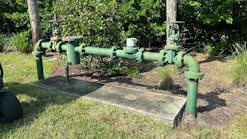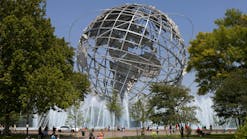Evaluating Irrigation Effectiveness
Who Is the MWDOC?
The Municipal Water District of Orange County (MWDOC) is dedicated to ensuring water reliability for the communities we serve. Our efforts are focused on sound planning and appropriate investment in water supply, regional delivery infrastructure, and emergency preparedness. Some 28 retail water agencies and cities rely on MWDOC for the imported water–supplies from northern California and the Colorado River–they provide their customers. Approximately half of Orange County’s water supply is imported. These countywide water utilities, known as MWDOC client agencies, also rely on the Municipal Water District to represent their interests on federal, state, and regional levels. MWDOC is a member of the Metropolitan Water District of Southern California (MET), which supplies imported water to six southern California counties. As a MET member, MWDOC represents the interests of its 28 Orange County client agencies.
MWDOC service area totals more than 600 square miles and serves approximately 2.27 million customers with a current water demand of up to 700,000 acre-feet per year. Figures 1 and 2 provide and overview of the geographical area and information about where Orange County gets its water.
MWDOC is a recognized leader in its water use efficiency programs. Through an innovative, multi-agency approach, MWDOC has formed partnerships with other federal, state, and local agencies to create award-winning water use efficiency programs that target all water users–residents, businesses, and industrial customers. Residential water use surveys, the ultra low-flush toilet rebate program, the landscape certification program, and the ET (outdoor irrigation system) rebate program are just some of MWDOC’s ongoing efforts to help maximize our water resources. These programs help save more than 2.9 billion gallons of water each year–water that can be used to meet increasing demands without developing new supplies. MWDOC, headquartered in Fountain Valley, CA, is governed by an elected seven-member Board of Directors. Each Board member is responsible for representing a specific area of the county.
Study Background and Methodology
In the summer of 2003, MWDOC was awarded a Proposition 13 Non-Point-Source Pollution Control Grant from the State Water Resources Control Board (SWRCB), to provide funding assistance for the installations of a new irrigation timer (Smart Timer) technology. As part of this grant, it is required of the lead agency (MWDOC) to capture both pre- and post-Smart Timer installation data for water quality and runoff flow for two distinct neighborhoods in Orange County, CA. In addition to this requirement, MWDOC is required to have a water savings evaluation performed on those Smart Timers installed through this program.
This grant titled “Orange County’s Weather Based Irrigation (Smart Timer) Timer Rebate Reimbursement Program” is founded on two earlier studies partnered by MWDOC and Irvine Ranch Water District (IRWD). Figure 3 is a summary of the evolution of the efforts in this area. The first study was conceptual in nature and is known as the Westpark Study, evaluated water demand reduction in Westpark neighborhood of Irvine, CA, after installation of 40 Smart Timers. The Westpark study identified water savings of 37 gallons per day (gpd), representing 7% of total household water use or approximately 16% of estimated outdoor use. This was followed by the Residential Runoff Reduction (R3) Study (R3 Study in Figure 3) (MWDOC, 2004). This study included five neighborhoods with isolated drainages. Three of these neighborhoods were control sites. A fourth neighborhood received education, and the fifth neighborhood received education and installation of Smart Timers. Water savings, runoff reduction, and improved runoff water quality were evaluated from these local sites. The R3 Study concluded that installation of Smart Timers resulted in 41 gallons-per-day savings (~10% of total household water use) for residential accounts. The “Education-only” group conserved 26 gpd (6% of household use). The study also concluded that for the dedicated landscape irrigation accounts there was a 575-gpd savings. The reduction in water consumption also resulted in less runoff into the storm drain system. It was observed that a 49% reduction in runoff occurred because of the application of proper water management.
The current study (Pilot Implementation Study in Figure 3) examines a countywide pilot implementation program involving a large number of Smart Timer installations and builds on the above two field studies. This study is divided into two parts. The first part of the study addressed water savings due to installation of approximately 1,700 Smart Timers in Orange County, installed from September 2004 through November 2006. These timers, which included eight different brands, have been installed in both residential homes and commercial sites. Professionals or homeowners did the installations. As part of this programwide evaluation, water savings were determined from a statistically valid sample by Smart Timer manufacturers, split between residential and commercial installations, seasonal variability, and type of installer.The second part of the study was to examine the role of Smart Timers in reducing the quantity of urban runoff and improving the water quality of the runoff. Sampling and measurements of water flows occurred in two areas of the County of Orange. The first, Portola Hills, is located in the city of Lake Forest, CA, with the second in the city of Newport Beach, CA. The Portola Hills neighborhood is a residential area, consisting of approximately 500 newer single-family homes. About 50 homes were retrofitted with Smart Timers in this neighborhood. Runoff flow and water quality measurements were taken during dry weather periods before and after installation of Smart Timers.
In Buck Gully, watershed irrigation for the common landscaped areas is fully and separately metered, under the control of approximately 15 homeowner associations (HOAs). Runoff flow and water quality measurements were done in two completely isolated watersheds. In one of the sites (Retrofit site), 32 of the 51 irrigation meters had Smart Timers installed in the common area irrigation systems. In the other site (Control site), none of the 37 HOAs had their irrigation systems retrofitted with Smart Timers. Pre- and post-installation runoff monitoring occurred during summer months of 2003 and 2006, respectively.
Study Goals and Objectives
The following were the study goals and objectives for the program:
- A determination of water savings for the entire program area by single-family residential installations
- A determination of water savings for the entire program area by commercial installations
- A determination of water savings by season, brand of Smart Timer, and type of installer
- Determination of runoff flow pattern during pre- and post-intervention period (in the Portola Hills and Buck Gully areas)
- Determination of water quality changes resulting from Smart Timer installation (in the Portola Hills and Buck Gully areas)
Study Results
The data collected during this study are compiled and evaluated for water savings; changes in dry weather runoff patterns and impact on runoff water quality, due to installation of Smart Timers. The results are summarized below:
Programwide Water Savings in SFR. The programwide installation of Smart Timers in Single-Family Residence (SFR) units resulted in an average water saving of 0.7 hundred cubic feet (HCF) per month (about 18.3 gpd; 0.0045 gpd per square-foot irrigated area). This estimate is arrived by calculating the total change in water use in cases where water use changed significantly (increased or decreased, α=0.05) and averaging the net change by all the Smart Timers (899) that were qualified for evaluation. However, the amount of water saving will increase to 1.4 HCF per month (35.7 gpd) if the estimates are made by averaging the net water change (significant increase or decrease) by only those Smart Timers (460) that contributed to significant change in water use.
Three distinct trends were observed in SFRs retrofitted with Smart Timers. In about 33% of the accounts, the water consumption significantly decreased (α=0.05) after installation of Smart Timers. In about 18% of the cases the water consumption increased statistically significantly after installation of Smart Timers. In nearly 50% of the accounts, water use did not change significantly upon installation of Smart Timers.
Programwide Water Savings by Commercial Installations. The programwide installation of Smart Timers in Commercial units resulted in an average water saving of 7.6 HCF per month (about 190 gpd; 0.004 gpd per square-foot irrigated area). This estimate is arrived by calculating the total change in water use in cases where water use changed significantly (increased or decreased) and averaging the net change by all the Smart Timers (323) that were qualified for evaluation. However, the amount of water saving will increase to 18.5 HCF per month (460 gpd) if the estimates are made by averaging the net water change (significant increase or decrease) by only those Smart Timers (134) that contributed to significant change in water use.
The overall trends observed in Commercial installations were similar to those in SFR installations. In about 30% of the accounts, the water consumption significantly decreased (α=0.05) after installation of Smart Timers. In about 11% of the cases, the water consumption increased significantly (α=0.05) after installation of Smart Timers. In nearly 60% of the accounts water use did not change significantly upon installation of Smart Timers.
Programwide Water Savings by Season. Programwide evaluation of pre- and post-intervention water use in SFR units indicated that significant water savings due to Smart Timers occurred in about six months of the year. These evaluations were performed using approximately four years of pre-intervention data and one year of post-intervention data. The water use increased significantly in two to three months (January to March) in SFR units installed with Smart Timers. No significant changes occurred in three or four months (June, July, November, and December) of a year. The savings typically occurred in spring, late summer, and early fall months. Water use increased during winter months. Figure 5 shows the programwide SFR observed water use during pre- and post-installation periods. The ET-adjusted water use pattern varied among the Coastal, Central, and Foothill regions of the study area. In general, the patterns seem to indicate an existing trend of under irrigation during spring months and over irrigation in the fall.
Water consumption in commercial units appear to follow the general trends observed with SFR, although, the savings occurred over eight months of the year. Figure 6 shows the observed programwide commercial water use during pre- and post-installation periods. As with the SFR installations, the ET adjusted water use pattern varied with the three ET zones evaluated in this study.
Programwide Water Savings by Smart Timer Brand. Seven different brands of Smart Timers were used in SFR units under this study. As a group, three of the brands (Brand A, Brand B, and Brand C) used significantly reduced water consumption in SFR units. In SFR units installed with one brand of Smart Timer (Brand E) the water use increased significantly. Furthermore, in all of these groups, less than 50% of the meters yielded statistically significant water savings. Statistically significant water savings occurred in less than 20% of the Smart Timers for two groups (Brand D and Brand E). Many factors such as location (ET Zone, City) of installation, ongoing public education, incentive programs, etc., can influence the differences in the performance of different brands. Additional studies are needed to determine the underlying reasons for the differences of water savings observed in this study.
Nine different brands of Smart Timers were used in Commercial units under this study. However, three brands (Brand B, Brand G, and Brand H) constituted 90% of the installations and about 24%, 35%, and 56% of the Smart Timers, respectively, of these brands yielded significant water savings during the study period. Additional studies are needed to determine the underlying reasons for the differences of water savings observed in this study.
Programwide Effect of Smart Timer Installation by Home Owners or Professional. The performance of Smart Timers in SFRs was evaluated for any differences in Smart Timer functioning due to the installer. There were 336 timers that were installed by owners, and the remaining 566 were installed by a professional contractor. There were 124 Smart Times installed by homeowners and 170 Smart Timers installed by professionals that significantly saved water. Statistical analysis indicated that a higher percentage of homeowners that installed Smart Timers (~37%) saved water, as compared to professionally installed Smart Timers (~30%). However, this study did not evaluate many factors that contributed to the differences in performance of the two groups. For example, it is possible that more professionally installed Smart Timers may be present in the Coastal area (lower ET where there is more savings variability), or cities where other conservation measures or rate structures also exist that may contribute to water savings irrespective of whether Smart Timers have been installed. Further investigations are suggested to identify the role of these factors.
Runoff Evaluation Due to Installation of Smart Timers. Runoff flow in the Retrofit area of Buck Gully in the post-intervention period (200 gpd per irrigated acre) was significantly lower than that of the Control area (420 gpd per irrigated area) during dry weather months of the post-intervention period. Comparison of pre- (Year 2003) and post-intervention (Year 2006) runoff indicated a reduction in runoff flow in the Control as well as the Retrofit areas. In the Control Area alone, the average runoff flow decreased from 669 gpd per acre in 2003 to 476 gpd per acre (net decrease of about 190 gpd per acre). Since there are no known Smart Timers in this area, the decrease in reduction may be attributed to other, non-Smart Timer factors–including, but not limited to operator education, financial incentives, better maintenance, etc. In the Retrofit Area, the runoff flow decreased from 545 to 175 gpd per acre (net decrease of 367 gpd per acre). Assuming the same factors were equally effective in both areas that caused water savings, the approximately 175 gpd per acre higher net decrease in runoff reduction can be assigned to the installation of Smart Timers in the Retrofit area.
In the Portola Hills area, the dry weather runoff flow during post-intervention period (Year 2006, 25,100 gpd) is about 55% lower than the runoff recorded during the pre-intervention period (Year 2005, 54,400 gpd). Since the decrease was so large, with only 10% of the homes having Smart Timers, it is likely that other factors–including, but not limited to public education, incentives, maintenance, etc.–may also have played a part in the observed reduction.
Runoff Water Quality Evaluation. No definite conclusions could be drawn from water quality analyses of either the Buck Gully or Portola Hills areas. In Buck Gully, the concentrations of conductivity (EC) and nitrate-related parameters appear to be higher in the Retrofit Area than in the Control Area. However, evaluation of the total mass indicated that only nitrite/nitrate nitrogen (NO2/NO3) and Total Nitrogen mass were significantly higher in the Retrofit Area runoff. The conductivity (and hence, possibly the total dissolved solids) flux (µmho/day/acre) was lower in the Retrofit Area. No significant change was observed between pre- and post-intervention periods in the Portola Hills runoff water quality. EC flux was the only parameter in Portola Hills that significantly decreased after Smart Timer installation.
Figure 7 shows the average runoff in Buck Gully control and retrofitted areas in 2006. The runoff flow for both areas was low in May and gradually increased in summer. Towards the end of summer, the runoff flow gradually decreased in the control area. However, in the retrofit area the decrease in runoff flow was more rapid in July, and it subsequently leveled off till October. This decrease in runoff is generally consistent with the water consumption pattern of the Buck Gully area landscape irrigation meters.
Figure 8 shows the runoff reduction in Buck Gully Control and Retrofit areas between the pre- and post-intervention periods. Since there are no known Smart Timers in this area, the decrease in reduction may be attributed to other, non-Smart Timer factors such as consumer education, financial incentives or weather-related irrigation reduction. In the Retrofit Area, the runoff flow decreased from 545 to 175 gpd per acre (net decrease of 367 gpd per acre). The reasons for decrease in runoff in the Retrofit Area may include all the factors associated with the control station in addition to the effect of Smart Timer installations.
Note that the net reduction in runoff for the Retrofit Area was larger than that for the Control Area by about 175 gpd per acre. This yields a reduction of 465 gpd per Smart Timer installed in the Retrofit Area during the evaluation period.
Findings and Recommendations
Water Savings for SFR Installations:
- Savings of 18.3 gpd for 899 water accounts
- 439 water accounts (49%) not significantly different
- 460 water accounts (51% had significant different water usage–294 saved, 166 used more
Water Savings for Commercial Installations:
- Net average savings of 35.7 gpd for SFR participants
- Savings of 190 gpd for 323 accounts
- 189 accounts (59%) not significantly different
- 134 accounts (41%) had significantly different water usage–98 saved, 36 used more
- Net average savings was 460 gpd
This article is based on the author’s presentation, “Effectivemes of Runoff-Reducing Weather-Based Irrigation Controllers (Smart TImers),” delivered at WaterEC 2009, in Newport Beach.
PLEASE NOTE
The data for this study were not normalized for weather with advanced statistical modeling.
The results obtained from the retrofit participants in this study were not compared to a control set of similar participants.
The weather data used in this study was found to be inaccurate due to malfunctioning weather equipment. All analyses using this inaccurate data are currently being re-run to provide accurate and finalized data in the final published report.




